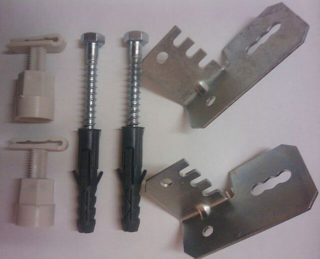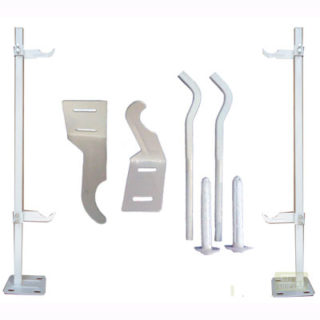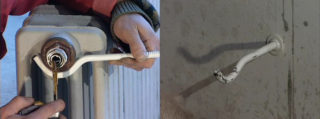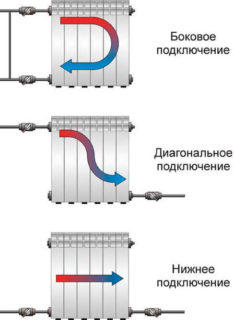In stores you can see a wide variety of heating appliances, but the classic types of batteries that are attached to the wall are still in great demand over the years.
Rules and regulations for installation
The installation location of the batteries is usually chosen near the window. To prevent the cold air from the glass from spreading throughout the room, there are standards at which heat transfer is carried out in full:
- the distance between the wall and the radiator from 3 to 5 cm;
- height from the floor is 8 or 12 cm;
- the distance from the windowsill is 8-12 cm.
The heater should occupy at least half of the window sill, this will allow heating a large area. In country houses, it is additionally recommended to insulate the room with the front door.
Brackets for installing radiators
The fastening of radiators to the wall plays a large role. Brackets are selected according to the type of battery. The following types of radiators are available:
- cast iron;
- steel;
- aluminum;
- bimetallic.
The mount for cast iron radiators is used in the form of powerful pins and pair hooks, since cast iron is a very heavy metal. To alleviate the severity of the structure, floor racks are used - this significantly reduces the load on the hooks. The number of holders depends on the sections. For 7-10 compartments, use 2 on top and 1 at the bottom, add 1 bracket to an additional 4-7 sections. The issue of choosing a mount for cast iron batteries must be approached with all responsibility, otherwise emergency situations are inevitable.
Steel batteries are divided into panel and tubular. Panel modifications to hook-hooks anchor into the wall, as well as cast-iron models. Due to its light weight, only 2-3 fasteners are enough. For tubular batteries use canopy brackets. The lower part of the battery is fixed with clips, which allows the structure to remain upright.
The fastening of aluminum radiators to the wall is similar to bimetallic ones, using special brackets. If it is not possible to mount the battery to the wall (made of drywall, glass or other fragile material), you can use floor mounts.
Installation of radiators
Even a beginner locksmith can carry out the installation of batteries, having instructions and small skills. The most optimal time for work is summer. However, usually repairs are carried out at the time of their need. First of all, you should correctly and accurately make the markup at the place of installation of the radiator. If you make a mistake in the calculations, the process of circulation of the liquid in the radiator will be disrupted.
To fix the cast-iron battery to the wall, in stone structures use pins that have threads at the end - they screw it into a wooden dowel.
In the monolithic walls, a pin is mounted with a plate at the end, which itself is fixed at 4 points in the hole. Often, structures are mounted on reinforced brackets consisting of a bracket and two fulcrum. With vertical installation, they make it possible to evenly distribute the weight of the radiator over the entire surface of the wall.
Steel panel batteries are mounted on hooks or rails. The hook is fixed to the wall by anchors, while on the other side it has special slots for hanging. Planks and clamps made of plastic greatly facilitate installation work.It is necessary to attach the latch to the wall and insert the bar, because of the small weight, there is no need for additional measures to be taken. The installation of tubular batteries is also carried out: the radiator is hung on two brackets evenly located at the fulcrum.
Fastening of bimetallic radiators to the wall is carried out in accordance with the document on the unit. Most often, the brackets are mounted on dowels and all this is securely fixed with cement mortar.
After carrying out the work, make sure that there is no gap between the mount and the hole. The slope of the radiator must not be less than 1 degree and exceed 1.5.
Features of mounting the radiator to the wall
When attaching the radiator to the wall in the first place, it is worth considering the location of objects around the battery so that there is no damage.
It is necessary to use drills of the same size with a dowel. Fasteners should be taken with a margin to avoid unforeseen situations. The way to connect to the system is taken into account in advance:
- unilateral;
- diagonal;
- saddle;
- lower.
If a one-way connection is used, a radiator with a large number of sections is not installed, since all segments cannot be filled. This adversely affects the indicators of heat transfer and significantly reduces the operational life. On a radiator, more than 10 sections use cross-connect to fill all sections.
With the lower connection, it is worth using floor brackets. The number of sections must be taken with the calculation of the quadrature. In a small room, do not mount a large radiator. But if the room has more than one window, you should install batteries under each of them.
In order not to damage the protective coating on the radiator, it is not recommended to remove the protective film before the end of construction work. After installation, it is important to ensure that the vent valve is at the top.






